The yellow-bellied poison frog, yellow-bellied poison-arrow frog, or yellowbelly poison frog is a species of frog in the family Dendrobatidae. It is found in northwestern Colombia and east-central Panama.
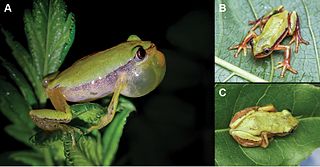
Afrixalus clarkei is a species of frog in the family Hyperoliidae. It is endemic to southwestern Ethiopia and has been recorded from near Chira, Jimma, Bonga, and Bodare. The specific name clarkei honours Mr and Mrs R. O. S. Clarke, who are acknowledged for their help and hospitality. Common name Clarke's banana frog has been coined for this species.
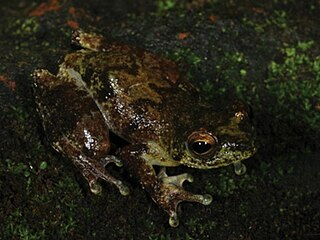
Hyperolius hypsiphonus is a species of frog in the family Hyperoliidae. It is found in southern Cameroon, Gabon, Equatorial Guinea, the western Republic of the Congo, and northwestern Angola. Common name cross-banded egg-guarding frog has been proposed for it.
Hyperolius obstetricans, or frilled egg-guarding frog, is a species of frog in the family Hyperoliidae. It is known from southern and south-western Cameroon, Equatorial Guinea, Gabon, and northern Angola; it is likely to occur in the intervening Republic of the Congo and Democratic Republic of the Congo.
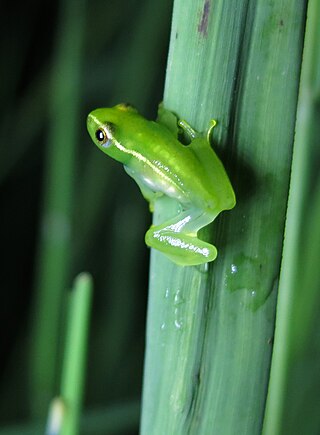
Hyperolius poweri is a species of frogs in the family Hyperoliidae. It is found in southeastern coast of South Africa and southern Mozambique. The specific name poweri honours John Hyacinth Power, Irish-born director of the McGregor Museum who collected amphibians as well as reptiles and plants. Accordingly, common names Power's reed frog and Power's long reed frog have been proposed for this species.
Hyperolius bopeleti, also known as the Dizangue reed frog or Bopelet's reed frog, is a species of frog in the family Hyperoliidae. It is endemic to the coastal southwestern Cameroon. The specific name bopeleti honours M. Bopelet, a Cameroonian biologist.
Hyperolius camerunensis is a species of reed frog in the family Hyperoliidae. It is endemic to western and southwestern Cameroon.
Hyperolius dintelmanni is a species of frogs in the family Hyperoliidae. It is endemic to Cameroon and found in the montane southwestern part of the country. Specifically, it has been recorded from the Bakossi Mountains, including the Edib Hills and Mount Kupe. The specific name, dintelmanni, honors Mr. Horst Dintelmann from Germany in recognition of "his support of taxonomic research and forthcoming conservation projects in Cameroon".
Hyperolius discodactylus is a species of frogs in the family Hyperoliidae. It occurs in the montane areas of eastern Democratic Republic of the Congo and western Uganda, Rwanda, and Burundi. It is also known as the Albertine Rift reed frog, highland reed frog, or disc-fingered reed frog.
Hyperolius igbettensis is a species of frog in the family Hyperoliidae. It is found in West Africa from Guinea eastward to Liberia, Ivory Coast, Ghana, Togo and Benin, Nigeria, and into Central Africa at least to Cameroon but likely further east to the Central African Republic and southwestern Chad; the eastern border of distribution of this species relative to other members in the Hyperolius nasutus complex is unclear. Common name Igbetti long reed frog has been coined for it. The type locality is near Igbetti, a village in Oyo State, Nigeria.
Hyperolius kihangensis, also known as the Kihanga reed frog or volcano reed frog, is a species of frogs in the family Hyperoliidae. It is endemic to the Udzungwa Mountains in south-central Tanzania.

Hyperolius nasutus is a species of frog in the family Hyperoliidae. Common names include long-nosed reed frog, sharp-nosed reed frog and long reed frog. It is known from northern Angola and northern Botswana, but it presumably occurs more widely. The nominal Hyperolius nasutus was partitioned in 2013 into three cryptic species, the other two being Hyperolius viridis and Hyperolius microps. All these species are members of the so-called Hyperolius nasutus species group, the "long reed frogs".
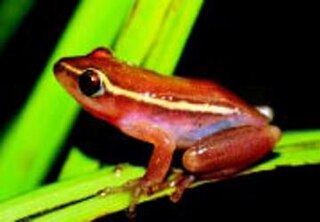
Pickersgill's reed frog, also known as Avoca reed frog, is a species of frog in the family Hyperoliidae. It is endemic to South Africa. It occurs in the coastal lowlands of KwaZulu-Natal between Sezela and St Lucia.
Hyperolius pseudargus, also known as the Mette's reed frog, is a species of frogs in the family Hyperoliidae. It is endemic to south-central Tanzania and occurs in the Udzungwa Mountains and south to Njombe in the Southern Highlands. Male Hyperolius pseudargus greatly resemble Hyperolius argus but have less webbing between the toes and the male advertisement call is different. The vernacular name refers to Mette Westergaard, Danish biologist who collected the holotype and is the junior describer of this species.
Hyperolius sheldricki is a species of small frog in the family Hyperoliidae. It is endemic to southeast Kenya. The type locality is in the Tsavo East National Park.
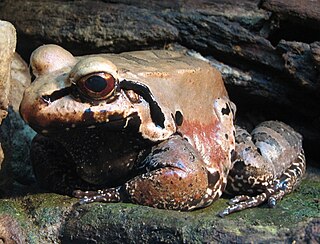
The smoky jungle frog is a species of frog in the family Leptodactylidae. It is found in Bolivia, Brazil, Colombia, Ecuador, Costa Rica, Panama, French Guiana, and Peru. Its natural habitats are tropical and subtropical moist broadleaf forests, subtropical or tropical swamps, subtropical or tropical moist montane forest, rivers, freshwater marshes, intermittent freshwater marshes, and aquaculture ponds.
Microkayla wettsteini is a species of frog in the family Strabomantidae. It is endemic to Bolivia and only known from the region of Unduavi in the Unduavi Valley, Sud Yungas Province, La Paz Department. Common names Wettstein's Andes frog and LaPlaca's Andes frog have been coined for it. It is named for Otto von Wettstein, Austrian zoologist.
Stefania tamacuarina is a species of frog in the family Hemiphractidae. It is found in the Sierra Tapirapecó in the Amazonas state of Venezuela as well as in the adjacent Amazonas state of Brazil. The specific name tamacuarina refers to the type locality, a spur ridge north of Pico Tamacuari.
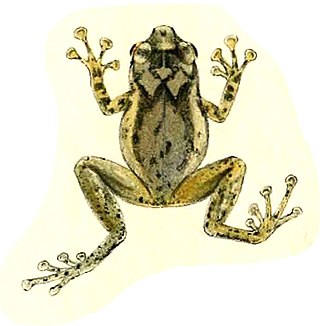
Oreophryne celebensis is a species of frog in the family Microhylidae. It is endemic to northern Sulawesi, Indonesia. Common name Celebes cross frog has been coined for it.
Cornufer citrinospilus is a species of frog in the family Ceratobatrachidae. It is endemic to the island of New Britain, Papua New Guinea, and is only known from the Nakanai Mountains of East New Britain Province. The specific name citrinospilus is derived from the Greek words kitrinos (="yellow") and pilos, in reference to the distinctive bright yellow flank areolations characteristic of this species.








